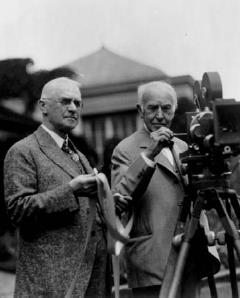Culture and RecreationPhotography |
When was photography invented? |
The concept of still photography dates back to the tenth century when Islamic scientists developed the camera obscura (Latin for “dark chamber”), a darkened enclosure with a small aperture (opening) to admit light. The light rays would cast an inverted image of external objects onto a flat surface opposite the aperture. This image could be studied and traced by someone working inside the camera obscura, or the image could be viewed from the outside of the camera, through a peephole.
In the sixteenth century, the Italian scientist Giambattista della Porta (c. 1535–1615) published his studies on fitting the aperture of the camera obscura with a lens to strengthen or enlarge the image projected. Made increasingly versatile through additional improvements, the camera obscura become popular among seventeenth-and eighteenth-century European artists.
But the camera obscura could only project (rather than reproduce) images onto a screen or a piece of paper. During the 1800s scientists experimented with ways of making the images permanent. Among those who made advances in the photographic process were French physicist Joseph-Nicéphore Niepce (1765–1833), who produced the first negative image in 1826; French painter Louis-Jacques Daguerre (1759–1851), who in 1839 succeeded in making a direct positive image on a silver plate, known as the daguerreotype; English scientist William Henry Fox Talbot (1800–1877), who developed a paper negative (c. 1841) that could be used to print any number of paper positives; and English astronomer Sir John Herschel (1792–1891), who was the first to produce a practical photographic fixing agent and the first to apply the terms “positive” and “negative” to photographic images. All of these milestones made photography a practical way of permanently recording real-life images.
The breakthrough in still photography was the Kodak, introduced in 1888 by American inventor George Eastman (1854–1932). The Kodak camera used film that was wound on rollers, eliminating the glass photographic plates that had been in use. The box-shaped camera made photography accessible to everyone—including amateurs. By the early 1900s the Eastman Kodak Company had become the largest photographic film and camera producer in the world. George Eastman has been credited with mass-producing the moment: Before the Kodak (a word he made up because he was fond of the letter k), photography had largely been the domain of professionals who were commissioned to take portraits of the well-to-do prominent members of society. Once the Kodak became widely available, photographs preserved the faces of ordinary people and the events of everyday life.

